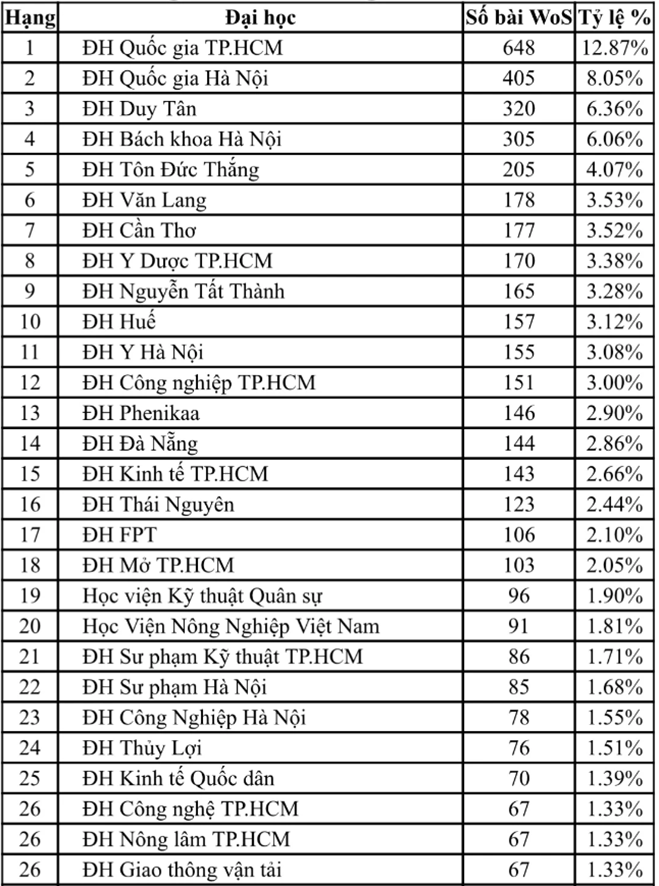Based on data from the American Web of Science (WoS), a study classified scientific articles by field and presented the international-standard research achievements by Vietnamese universities in the first half of 2024.
Dr Le Van Ut, Head of the Scientometrics and Research Administration Policies (SARAP) Group at Van Lang University in Ho Chi Minh City (HCMC), announced a study on the international-standard scientific research achievements by Vietnamese universities in the first half of 2024.

According to MoET Higher education regulations, the average number of articles in WoS or Scopus
(weighted by field) per lecturer and per year at a university with PhD
training must not be less than 0.3. PHAM HUU
Dr Ut based the data and analysis in his study on the WoS database, currently considered the most reputable scientific database in the world. He extracted international publications from Vietnam from January 1 to June 30, 2024, with the extraction point at 9 PM on July 1.
VNU HCMC in the lead
The results show that Vietnam had 5,431 scientific articles recorded by WoS, falling into 13 types. Research articles account for the majority (92.69%) of Vietnamese WoS publications at 5,034 papers. Of review articles there are only 220, accounting for 4.05%.

Percentage of Vietnamese papers by field recorded by WoS
Papers in sciences expanded (SCIE) accounted for 68%, taking up the majority. The social sciences (SSCI) are more modest, accounting for 9.89%. Only 0.7% of the papers are in arts & humanities (AHCI). Papers classified as emerging sources (ESCI) account for 23.72%.


Percentage of Vietnamese papers by field recorded by WoS
Papers in sciences expanded (SCIE) accounted for 68%, taking up the majority. The social sciences (SSCI) are more modest, accounting for 9.89%. Only 0.7% of the papers are in arts & humanities (AHCI). Papers classified as emerging sources (ESCI) account for 23.72%.
It should be noted that each paper can be listed in at least one field.
Dr Ut also presented the top 50 universities with the most articles recorded by WoS. A total of 60 universities (out of 240) claimed twenty or more WoS-standard papers.

60 out of 240 higher education institutions with highest number
of international-standard papers in the WoS data. SCREENSHOT
Most of these are public universities, accounting for 88.33% or 53 institutions, and only 7 or 11.66% are private. In the top 10, VNU HCMC ranks first with 648 research papers, accounting for 12.87% of the national total. VNU Hanoi comes second with 405 research papers. The remaining positions are held by DTU, the Hanoi University of Science & Technology, Ton Duc Thang University, Van Lang University, Can Tho University, the University of Medicine & Pharmacy at HCMC, Nguyen Tat Thanh University, and Hue University.
These ten highest-ranking universities account for 54.24% of all research papers coming from Vietnam.
180 universities with fewer than twenty papers in six months
“Besides the top 50 comprising the 60 universities with at least twenty WoS research papers, there are 180 higher education institutions with fewer than twenty WoS-standard papers (formerly ISI) in the first half of the year,” Dr Ut comments. “This means that the quantity and quality of scientific research at many universities are at an alarming level.” VNU HCMC leads the list with most international-standard scientific papers in the first half of the year
To explain why he considers universities with fewer than twenty international publications in half a year alarming, Dr Ut says, “Circular 01 of 2024 by the Ministry of Education & Training on higher education institution standards, criterion 6.2 clearly says that: The average number of science & technology publications per full-time lecturer must not be less than 0.3 papers per year; for institutions with PhD training not limited to specific fields, not less than 0.6 papers per year, with not less than 0.3 papers listed in WoS or Scopus (weighted by field) per year.”
Dr Ut gives an example: Dong Nai University of Technology published 21 papers in the first half of 2024. The university website lists 291 lecturers (as of June 11, 2023). The total number of papers for 2024 can be taken to be 42, plus or minus.
“If we divide 42 by 291, we get 0.144,” Dr Ut explains. “If we include field weights and articles not in WoS but listed in Scopus plus end-of-term productivity, the ratio could approach 0.3. This indicates that institutions with PhD programs but fewer than twenty publications in the first half of 2024 are in the alarm group regarding quantity and quality of their scientific research. For non-doctoral training institutions, the situation is less pressing.”
Dr Ut believes that a high-quality lecturer must have good professional expertise, good teaching methods, and good scientific research capabilities. Only by doing scientific research can lecturers produce new research results in their field. This will improve the quality of their lectures and lead to valuable theses and dissertations.
|
Short-term research allows universities to make timely adjustments
According to Dr Ut, he has been researching the issue for over ten years primarily for advisory purposes, but this is the first time he is publishing his work as novel research results. The research has also been published in the Vietnam Journal of Science, Technology, & Engineering of the Ministry of Science & Technology.
“Timely research achievement information (half-year or current-year) can provide up-to-date and useful information to governmental higher education management agencies, university governing bodies, researchers, and the community about university achievements,” Dr Ut explains. “Based on it, universities can implement effective strategies and make timely adjustments to arising issues that may lead to risks in university management.”
|
(Media Center)